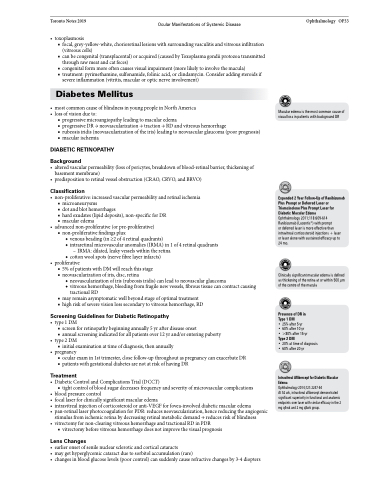Page 923 - TNFlipTest
P. 923
Toronto Notes 2019 Ocular Manifestations of Systemic Disease
• toxoplasmosis
■ focal, grey-yellow-white, chorioretinal lesions with surrounding vasculitis and vitreous infiltration
(vitreous cells)
■ can be congenital (transplacental) or acquired (caused by Toxoplasma gondii protozoa transmitted
through raw meat and cat feces)
■ congenital form more often causes visual impairment (more likely to involve the macula)
■ treatment: pyrimethamine, sulfonamide, folinic acid, or clindamycin. Consider adding steroids if
severe inflammation (vitritis, macular or optic nerve involvement)
Diabetes Mellitus
• mostcommoncauseofblindnessinyoungpeopleinNorthAmerica • lossofvisiondueto:
■ progressive microangiopathy leading to macular edema
■ progressiveDR→neovascularization→traction→RDandvitreoushemorrhage
■ rubeosis iridis (neovascularization of the iris) leading to neovascular glaucoma (poor prognosis) ■ macular ischemia
DIABETIC RETINOPATHY
Background
• alteredvascularpermeability(lossofpericytes,breakdownofblood-retinalbarrier,thickeningof basement membrane)
• predispositiontoretinalvesselobstruction(CRAO,CRVO,andBRVO)
Classification
• non-proliferative:increasedvascularpermeabilityandretinalischemia ■ microaneurysms
■ dot and blot hemorrhages
■ hard exudates (lipid deposits), non-specific for DR
■ macular edema
• advancednon-proliferative(orpre-proliferative)
■ non-proliferative findings plus:
◆ venous beading (in ≥2 of 4 retinal quadrants)
◆ intraretinal microvascular anomalies (IRMA) in 1 of 4 retinal quadrants
– IRMA: dilated, leaky vessels within the retina ◆ cotton wool spots (nerve fibre layer infarcts)
• proliferative
■ 5% of patients with DM will reach this stage ■ neovascularization of iris, disc, retina
◆ neovascularization of iris (rubeosis iridis) can lead to neovascular glaucoma
◆ vitreous hemorrhage, bleeding from fragile new vessels, fibrous tissue can contract causing
tractional RD
■ may remain asymptomatic well beyond stage of optimal treatment
■ high risk of severe vision loss secondary to vitreous hemorrhage, RD
Screening Guidelines for Diabetic Retinopathy
• type1DM
■ screen for retinopathy beginning annually 5 yr after disease onset
■ annual screening indicated for all patients over 12 yr and/or entering puberty
• type2DM
■ initial examination at time of diagnosis, then annually
• pregnancy
■ ocular exam in 1st trimester, close follow-up throughout as pregnancy can exacerbate DR ■ patients with gestational diabetes are not at risk of having DR
Treatment
• DiabeticControlandComplicationsTrial(DCCT)
■ tight control of blood sugar decreases frequency and severity of microvascular complications
• bloodpressurecontrol
• focallaserforclinicallysignificantmacularedema
• intravitrealinjectionofcorticosteroidoranti-VEGFforfovea-involveddiabeticmacularedema
• pan-retinallaserphotocoagulationforPDR:reducesneovascularization,hencereducingtheangiogenic
stimulus from ischemic retina by decreasing retinal metabolic demand → reduces risk of blindness
• vitrectomyfornon-clearingvitreoushemorrhageandtractionalRDinPDR
■ vitrectomy before vitreous hemorrhage does not improve the visual prognosis
Lens Changes
• earlieronsetofsenilenuclearscleroticandcorticalcataracts
• maygethyperglycemiccataractduetosorbitolaccumulation(rare)
• changesinbloodglucoselevels(poorcontrol)cansuddenlycauserefractivechangesby3-4diopters
Ophthalmology OP33
Macular edema is the most common cause of visual loss in patients with background DR
Expanded 2 Year Follow-Up of Ranibizumab Plus Prompt or Deferred Laser or Triamcinolone Plus Prompt Laser for Diabetic Macular Edema
Ophthalmology 2011;118:609-614
® Ranibizumab(Lucentis )withprompt
or deferred laser is more effective than intravitreal corticosteroid injections + laser or laser alone with sustained efficacy up to 24 mo.
Clinically significant macular edema is defined as thickening of the retina at or within 500 μm of the centre of the macula
Presence of DR in Type 1 DM
• 25% after 5 yr
• 60% after 10 yr • >80% after 15 yr Type 2 DM
• 20% at time of diagnosis • 60% after 20 yr
Intravitreal Aflibercept for Diabetic Macular Edema
Ophthalmology 2014;121:2247-54
At 52 wk, intravitreal aflibercept demonstrated significant superiority in functional and anatomic endpoints over laser with similar efficacy in the 2 mg q4wk and 2 mg q8wk group.


